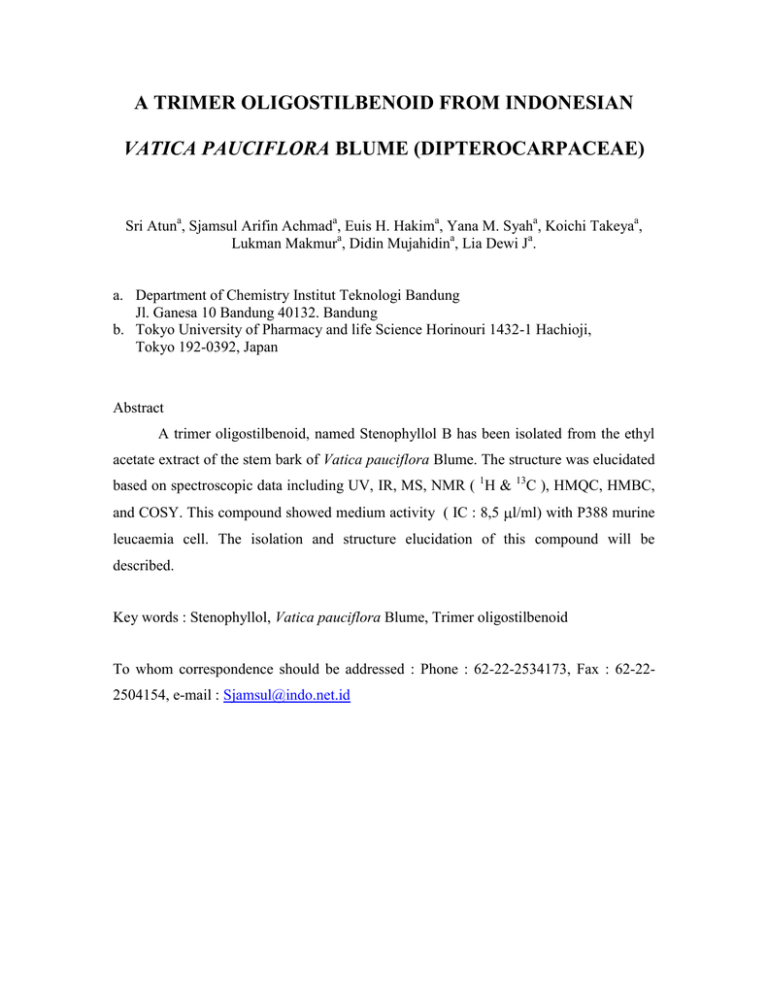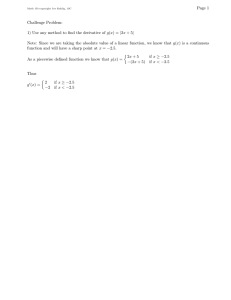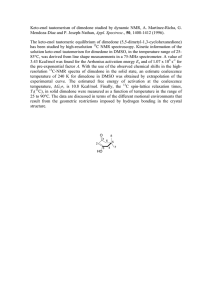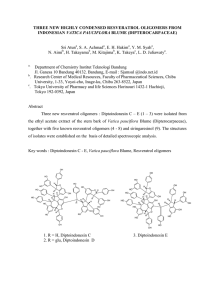A TRIMER OLIGOSTILBENOID FROM INDONESIAN VATICA PAUCIFLORA
advertisement

A TRIMER OLIGOSTILBENOID FROM INDONESIAN VATICA PAUCIFLORA BLUME (DIPTEROCARPACEAE) Sri Atuna, Sjamsul Arifin Achmada, Euis H. Hakima, Yana M. Syaha, Koichi Takeyaa, Lukman Makmura, Didin Mujahidina, Lia Dewi Ja. a. Department of Chemistry Institut Teknologi Bandung Jl. Ganesa 10 Bandung 40132. Bandung b. Tokyo University of Pharmacy and life Science Horinouri 1432-1 Hachioji, Tokyo 192-0392, Japan Abstract A trimer oligostilbenoid, named Stenophyllol B has been isolated from the ethyl acetate extract of the stem bark of Vatica pauciflora Blume. The structure was elucidated based on spectroscopic data including UV, IR, MS, NMR ( 1H & 13C ), HMQC, HMBC, and COSY. This compound showed medium activity ( IC : 8,5 l/ml) with P388 murine leucaemia cell. The isolation and structure elucidation of this compound will be described. Key words : Stenophyllol, Vatica pauciflora Blume, Trimer oligostilbenoid To whom correspondence should be addressed : Phone : 62-22-2534173, Fax : 62-222504154, e-mail : Sjamsul@indo.net.id Introduction Dipterocarpaceae is one of the largest families found in the tropical forest Indonesia. The plants are distributed from the west of Indonesia until Papua (Irian Jaya) and the mostly in Kalimantan, there fore the timber of these plants are ussually called “ meranti” or “ Kayu Kalimantan”. Dipterocarpaceae consists of about 16 genus and 600 secies 1,2 and until now only few species have been investigated. Some chemical constituents that can be found from this plants include arilpropanoid, benzofuran, flavanoid, polyphenol, oligostilbenoids, and terpenoid 2,3 . The oligostilbenoids from Dipterocarpaceae plants have various structure from simple structure as like resveratrol monomer, resveratrol dimer, resveratrol trimer, until resveratrol hexamer 4. These structure are very interesting and showed interesting biological activity, such as antibacterial, anticancer, antihepatotoxic, and anti-HIV. Thus Dipterocarpaceae plants are very potential for chemical research in natural product and pharmaceutical industry. Recently a number of novel had been reported such as resveratrol-12C- -glucopyranoside (1) from Shorea hemsleyana 5, -viniferin (2) from V. affinis 6, -viniferin (3) from S. hemsleyana 5, hopeaphenol (5) from S. hemsleyana 5, and vaticanol D (5)from V. rassak 4. The aims of this research is to isolate, determine structure and biological activity of these compounds from V. pauciflora. Until now these species never have been investigated by other researches. Thus in the present work we report on the isolation, structure determination, and biological activity of a trimer oligostilbenoid. Stenophyllol B (6) obtained from the fraction ethyl acetate. The biological activity of these compound were evaluated against P388 murine leucaemia cells. glu OH OH OH OH O H H OH OH OH OH (1) (2) O H O H H OH H Oh H O OH OH OH H OH H H H OH OH OH H O OH OH H OH H OH OH OH O OH (3) (4) OH OH OH OH OH H H OHOH H OH H OH H H OH OH HH OH OH H OH O OH H OH OH Vatikanol D (5) OH O OH A1 H B2 OH OH A2 H H H B1 H OH OH H C1 C2 OH OH 6 Experimental Section General Experimental Procedures Melting points were determined on a micro melting point apparatus and are uncorrected. Optical rotation was measured in MeOH on a JASCO DIP-370 digital polarimeter. UV and IR spectra were obtained using varian Cary 100 Conc and one Perl\kin Elmer Spectrophotometers. 1H and 13 C NMR spectra were recorded with JNM A 6000 spectrometer operating at 500 MHZ (1H ) and 500 MHZ (13 C) using TMS as an internal standart. FAB-MS were obtained with Jeol JMS- AM 20 mass spectrometer using the EI mode. VLC was carried out using Merk Si-gel 60 GF254, flash chromatography with Merk Si-gel 60 (230 – 400 mesh), and TLC analysis on precoated Si-gel plates (Merk kieselgel 60 F254 0,25 mm ). Plant Material Sample of the steam bark of V. pauciflora were collected in September 2000 from the research garden Dramaga Bogor , Indonesia. The plant was identified by the staff at the Herbarium Bogorienses, Bogor, Indonesia. Bioactivity Test The sitotoxycity of the compound was eva;luated with P388 Murine leucaemia cells. Extraction and Isolation The milled dried steam bark (5 Kg) was extracted exhaustively with MeOH ( 3 x 15 L) for 24 hours. The combined extracts were evaporated under reduced pressure to small volume. The extract was fractionated with hexane ( 3 x 500 ml), methylena chloride ( 3 x 500 ml) and then with ethyl acetate. A part of the ethyl acetate fraction (35 gr) was preabsorbed on silica gel and chromatographed over a colum of silica gel with amounts of hexane in ethyl acetate as eluent with increased gradient polarity. Fraction which gave the same Rf on TLC were combined and rechromatographed in the same way. The less polar fraction yielded material which was purified by repeated chromatography to give S-1 (6) as amorf pale yellow (42 mg). Stenophyllol B was obtained as amorf pale yellow, m.p 230 oC (decompous), [ ]D : -20 (in 0,1 MeOH), UV (MeOH) max : 205; 230 (sh); 285 nm, IR (KBr) max : 3393 (OH); 1613; 1462; (C=C aromatik); 1337; 1231;1171; 1124; and 831 Cm-1. 1H- NMR ( AC2O, 500 MHZ) and 13C – NMR see Table 1. FAB-MS m/z (relative intensity) [M+ + 1]+ : 680,89 (84); 613,35 (20); 573,38 (20); 466,37 (100); and 391 (36). Discussion The FABMS of stenophyllol B (6) gave an [M]+ ion at m/z 680 consistent with a molecular formula of C42H32O9 and is regarded as a stilbene trimer. The IR spectrum of compound 6 showed absorbtions broads typical of hydroxyl (3393 Cm-1), aromatic ring ( 1613; 1462; 1337 Cm-1) and a prominent band at 831 Cm-1 indicative of 1, 4 disubstituted aromatic ring. The predicted structure of 6 was further confirmed by the NMR data ( 1H and 13C) (Table 1) including HMQC, H-H COSY, and HMBC and compared with those reported in literature 7. It can be seen from the NMR ( 1H and 13C) spectral data of 6 (Table 1). The 1H – NMR spectrum showed the presence of three sets of NMR coupled aromatic protons assignable to three 4 – hidroxyphenyl groups [ 6,89 (2 H, d. J : 8,5 Hz, H 2a, 6a); 6,75 ( 2 H, d, J : 8,5 Hz, H 3a, 5a); 7,22 ( 2H, d, J : 8,5 Hz, H 2c, 6c); 6,70 ( 2 H, d, 8,9, H 3c, 5c)], three sets of proton assignable to 1,2,3,5-tetra substituted benzene rings [ 6,33 ( 1 H, d, J : 2,2 Hz, H 12a); 6,26 ( 1 H, d, 2,2 Hz, H 14a); 6,23 ( 1H, d 1,6 Hz, H 12b); 6,79 ( 1 H, br s ), H 14b); 6,08 ( 1 H, m, H 12c and 14 c ), a set mutually coupled aliphatic methines [ 5,85 ( 1 H, d, J : 4,0 Hz, H 7a); 5,09 ( 1 H, d, J : 3,9 Hz, H 8a)], a sequence of aliphatic methine protons coupled succesively in this order [ 4,75 ( 1 H, d, J: 6,6, H 7b), 3,44 ( 1 H, dd, J : 6,5; 7,0 Hz, H 8b); 4,34 (1H dd, J : 9,5; 7,8 Hz, H 8c); 5,38 ( 1H, d, J : 9,9, H 7c)], in addition to eight phenolic hydroxyl groups ( 7,9; 8,6). Table 1. The NMR ( 1H and 13C ) spectral data of compound 6 and stenophyllol B No 1a 2a,6a 3a,5a 4a 7a 8a 9a 10a 11a 12a 13a 14a 1b 2b,6b 3b,5b 4b 7b 8b 9b 10b 11b 12b 13b 14b 1c 2c,6c 3c,5c 4c 7c 8c 9c 10c 11c 12c 13c 14c Compound 6 H (Ac2O 500 C MHZ) (Ac2O, 500 MHZ) 134,4 6,89 (d 8,5) 127,9 6,75 (d 8,5) 115,8 157,5 5,85 (d 4,0) 87,9 5,09 (d 3,9) 52,4 141,2 123,3 156,3 6,33 (d 2,2) 104,8 157,9 6,26 (d 2,2) 104,8 139,4 7,22 (d 8,4) 129,9 6,68 (d 8,7) 115,7 155,9 4,75 (d 6,6) 51,7 3,44 (dd 6,5;7,0) 56,2 143,9 120,4 160,2 6,23 (d 1,6) 95,8 158,6 6,79 (br s) 106,7 136,7 7,31 (d 8,5) 129,8 6,70 (d 8,9) 115,7 156,0 5,38 (d 9,9) 47,1 4,34 (dd 9,5; 53,4 7,8) 150,6 123,3 154,5 6,08 (m) 102,2 158,9 6,08(m) 102,9 Stenophyllol B H (Ac 2O 500 C MHZ) Ac2O, 500 MHZ)) 134,6 6,89 (d 8,8) 127,2 6,76 (d 8,8) 116,0 157,6 5,84 (d 3,9) 88,0 5,09 (d 3,9) 52,5 141,4 123,4 156,5 6,26 (d 1,9) 101,3 158,1 6,26 (d 1,9) 105,0 136,9 7,21(d 8,5) 130,0 6,68 (d 8,5) 115,8 156,1 4,73 (d 6,3) 51,9 3,43 (brd 6,3) 56,4 144,1 120,6 160,4 6,24 (d 1,9) 95,9 158,7 6,80 (br s) 106,8 139,5 7,31 (d 8,5) 129,9 6,70 (d 8,5) 115,8 156,2 5,37 (d 9,8) 42,2 4,34 (dd 9,8; 7,8) 53,5 6,08 (m) 6,08 (m) 150,8 123,4 154,6 102,3 154,6 103,1 All protonated carbon signals in the 13C-NMR spectrum were assigned completely by the HMQC spectrum and are listed in Table 1. The 13C- NMR spectrum of 6 exhibited fourty two signals corresponded to six methine alifatic carbon at [ 47,1; 51,7; 52,4; 53,4; 56,2; 87,9], eighteen methine aromatic carbon at [ 2 x 127,9; 2 x 115,8; 101,2; 104,8; 2 x 129,9; 2 x 115,7; 95,8; 106,7; 2 x 129,8; 2 x 115,7; 102,2, 102,9] and nine quarternary carbon at [ 134,4; 141,2; 123,3; 139,4; 143,9; 120,4; 136,7; 150,6; 123,3], lowfield signals at [ 157,5; 156,3; 157,9; 155,9; 160,2; 158,6; 156,0; 154,5; 158,9 ] were assigned to nine oxyaryl carbons. Assignment for all the fuctional groups in compound 6 we achieved by heteronuclear multiple quantum coherence (HMQC) and heteronuclear multiple bond connectivity (HMBC) experiment. In the HMBC spectrum of 6 showed 13 C – 1H long range correlations were observed between C-2a(6a) / H – 7a, C-8a/ H-14a; C-9b/ H-8a; C-9b/ H-14 b; and C-7c/ H-2c(6c); C-8c / H-7b; C-7b/ H-2b(6b) (Fig. 1). In the 1H – 1H long range COSY spectrum, the mutually coupled methine protons ( H-7a and H-8a) were correlated with H-2a (6a) and H-14a respectively. The long range correlation were observed to between H-7c / H-8c; H-8c/ H-8b; H-7b / H-2b(6b) (fig 2). These result indicated that a resveratrol unit formed a 2,3- aryldihydrobenzofuran skeleton through ring B2. These spectroscopic evidence were in agreement with the proposed structur assigned to stenophyllol B (6) came from comparison of the NMR ( 1H and 13C) to those reported in the literatures 7. H 3a H H OH 11b 3b A H H 10c 12a 10a H 11a 8c 4b H OH 13a 7b 1b 5b H 14a H H 2b OH 7c H 9c H 5a 6a H 9a 9b 8b OH A1 8a 10b H H 7a OH 4a 1a 13b 14b H H O 12b 2a H 1c 6c 6b H OH HH 2c 11c 14c H 13c 12c OH 5c 4c 3c H H OH Fig. Significant HMBC Correlation of Stenophyllol B H 3a H H OH 11b 3b 9b OH H 10c H OH 7c 9c H H 1c 6c 6b H OH 12a 10a 11a 8c H A 7b 4b 5b 13a H 8b H OH 14a H H OH H 9a 2b 1b 5a 6a H 8a 10b H H 7a 4a A1 1a 13b 14b H H O 12b 2a HH 2c 11c H 14c 12c 13c OH 5c H 3c H 4c OH Fig 2. Significant H-H Cosy Correlations of Stenophyllol B These compound showed medium activity ( IC 8,5 g/ml) with P388 murine leuceimia cells. A trimer oligostilbenoids type have been isolated from several other Dipterocarpaceae and Leguminace species 7,8,9. Acknowledgment The authors are grateful to rearch garden at Dramaga Bogor and Staff at the herbarium Bogorienses Bogor, Indonesia for identification speciment sample . Refference 1. Hegnaeur R. (1966) Chemotaxonomic Der Pflanzen, Birkauser Verlag Based, Stuttgard, 31-39 2. Cronquist A, (1981) An Integrated System of Classification of Flowering Plants, Columbia Univ. Press, New York, 316 – 318. 3. Tanaka T, T. Ito, Y Ido, T.K. Son, K. Nakaya, M. Linuma, M. Ohyama (2000) Oligostilbenoids in Stem bark of Vatica rassak, Phytochemistry, 53, 1015- 1019. 4. Tanaka T, T. Ito, K. Nakaya, M. Iimuna, Y. Takashi, H. Naganawa, N. Matsura, M. Ubukata (2000) Vaticanol D, a Novel Resveratrol hexamer Isolated from Vatica Rassak, Tetrahedron Letter, 41, 7929 –7932. 5. Ito Tetsuro, T. Tanaka, Y. Ido, K. Nakaya, M. Iinuma, S. Riswan (2000) Stilbenoids isolated from Stem Bark of Shorea hemleyana, Chem. Pharm. Bull, 48 (7), 1001 – 1005. 6. Sotheeswaran S, M.U.S. Sultanbawa, S. Surendrakumar, S. Balasubramaniam, P. Bladon (1985) Polyphenols from Dipterocarphaceae Species Vaticaffinol and viniferin, J. Chem. Soc. Perkin. Trans , 159 – 162. 7. Ohyama M., T. Tanaka, M. Iinuma, C.l. Burandt Jr (1998) Phenolic Compounds Isolated from The Roots of Sophora Stenophylla, Pharm. Soc. Of Japan, 46 (4), 663668. 8. Sultanbawa M.U.S, S. Surendrakumar, P. Bladon (1987) Distichol an Antibacterial Polyphenol from Shorea Disticha, Phytochemistry, 26 (23), 799 –801. 9. Tanaka T, T. Ito, M. Iinuma, M. Ohyama, M. Ichise, Y. Tateishi (2000) Stilbene Oligomers in Roots of Sophora davidii, Phytochemistry, 53, 1009 –1014.







